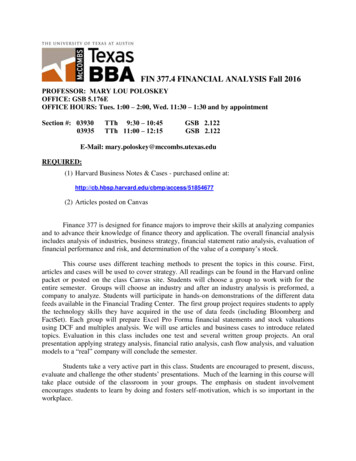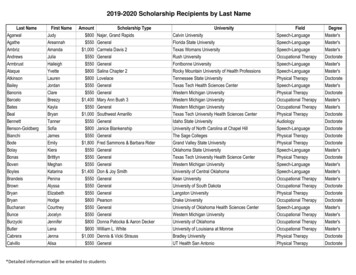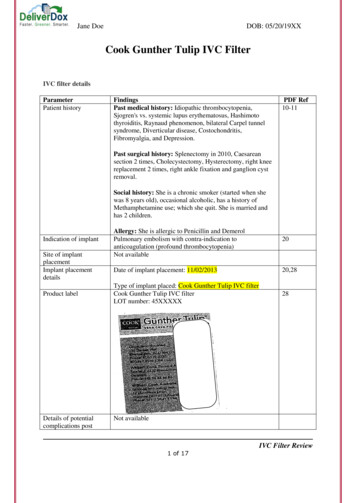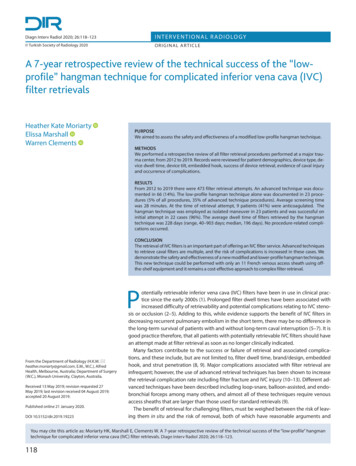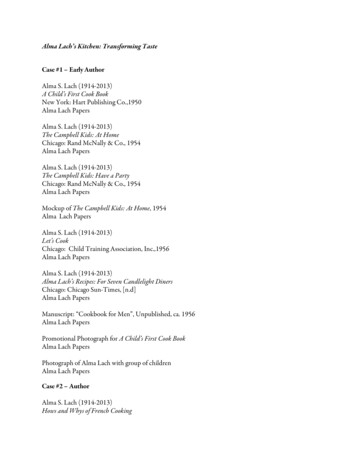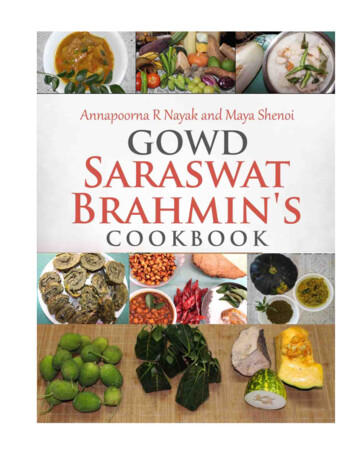
Transcription
2"GOWD"SARASWAT"BRAHMIN’S"COOKBOOK!2" GOWD"SARASWAT"BRAHMIN’S"COOKBOOK!
GOWD"SARASWAT"BRAHMIN’S"COOKBOOK" 3!Gowd Saraswat Brahmin’s Cookbook by Annapoorna Nayak and Maya Shenoi 2016 by Annapoorna Nayak and Maya Shenoi All rights reserved.No part of this publication may be reproduced, distributed, or transmitted in anyform or by any means, including photocopying, recording, or other electronic ormechanical methods, without the prior written permission of the authors,Annapoorna Nayak and Maya Shenoi, except in the case of brief quotationsembodied in critical reviews and certain other noncommercial uses permitted bycopyright law.GOWD"SARASWAT"BRAHMIN’S"COOKBOOK" 3!
4"GOWD"SARASWAT"BRAHMIN’S"COOKBOOK!Limit of Liability and Disclaimer of WarrantyWe have used our best efforts in preparing the Recipe Book, and the information is provided “asis.” We make no representation or warranties on the accuracy or completeness of the contents ofthe cookbook and we specifically disclaim any implied warranties of merchantability or fitnessfor any particular purpose.We are not responsible for the outcome of any recipe you try from this book. You may notachieve the results desired due to variations in ingredients, cooking temperatures, typos, errors,omissions, or individual cooking ability. You should always use your best judgment. Youshould always take care not to injure yourself or others on sharp knives or other cookingimplements or to burn yourself or others while cooking.You should examine the contents of ingredients before preparation and consumption of theserecipes to be fully aware of and to accurately advise others of the presence of substances thatmight provoke an adverse reaction in some consumers, even if the recipe is marked as specificallergen free.All material in the Recipe Book is provided for your information only and may not beconstrued as medical advice or instruction. No action or inaction should be taken based solelyon the contents of this information; instead, readers should consult appropriate healthprofessionals on any matter relating to their health and well being.WE DO NOT CLAIM TO BE DOCTORS, NUTRITIONISTS OR DIETITIANS. THEINFORMATION IN THE RECIPE BOOK IS MERELY OUR OPINION AND DOES NOTREPLACE PROFESSIONAL MEDICAL OR NUTRITIONAL ADVICE.In no event will we be liable for any loss or damage including without limitation, indirect orconsequential loss or damage, or any loss or damage whatsoever arising from loss of health,fitness, data or profits arising out of, or in connection with, the use of this book.Social equalityWe believe in social equality, where all people within a specific society or isolated group havethe same status in some ways, often including civil rights, freedom of speech, property rights,and equal access to social goods and services.This book is about the cuisine of a specific community called ‘Gowd Saraswat Brahmin’ (GSB).The mention of ‘Brahmin’ is not meant to bring attention to the caste system or glorify caste.GSB is more of a community rather than just a Brahmin caste. This community could hardly be afew hundred thousand in population. The point of this book is to document the culinary cultureof this dwindling community. Such cookbooks not only help preserve our culinary history andfood culture but they also help open up our unique way of life and share it with the world.We do not intend to hurt the sentiments of any individual/group or organization, however wecannot be held responsible for the presence of any information that may upset or violate aparticular custom or tradition, unknowingly.4" GOWD"SARASWAT"BRAHMIN’S"COOKBOOK!
GOWD"SARASWAT"BRAHMIN’S"COOKBOOK" 5!DedicationThis Book is primarily dedicated to my beloved Mother, from whom I learned the fun ofcooking and also to the recipes that are all very traditionally Konkani.Apart from my Mother, my gratitude and special thanks to my husband and children –Rajeev, Rahul and Shivika who helped to make this book a colorful one through theirvaluable inputs.Special thanks also to the Co-author and my cousin - Maya Shenoi who gave all theencouragement and inspiration to be a part of this venture.”- Annapoorna NayakDedicated to my parents and brother, for everything!Special thanks to my cousins Anou Athri Vats, Ranjit Kamath and my sisters-in-lawSylvia Shenoi, Preeti Athri for their positive support and encouragement in order tomake this book a reality!- Maya ShenoiGOWD"SARASWAT"BRAHMIN’S"COOKBOOK" 5!
tarian: All recipes mentioned here use only grains, pulses, nuts,seeds, vegetables and fruits, with the use of dairy products. This symbolwill be marked on top of all vegetarian recipes.Vegan: Some recipes mentioned here are vegan. They exclude anythingof animal origin, including dairy products, honey, eggs and meat. Thissymbol will be marked on top of such recipesGluten Free: Most of the recipes mentioned here exclude gluten, aprotein composite found in wheat, barley, and rye. This symbol will bemarked on top of such recipes.Nut Free: Most of the recipes mentioned here exclude nuts, which mayhave allergens that can be problematic to those allergic to nuts. Thissymbol will be marked on top of such recipes.Low Fat: Quite a few of the recipes have extremely low fat and oilcontent. This symbol will be marked on top of such recipesQuick: Quite a few of the recipes can be made in under 30 minutes if allingredients are prepped and ready at the kitchen counter beforepreparation begins. This symbol will be marked on top of such recipesMeasurementMeasure1 teaspoon1 tablespoon1/4 cup1/2 cup1 cup1 bowlEquivalency5 milliliters3 teaspoons (15 milliliters)4 tablespoons (59 milliliters)8 tablespoons (118 milliliters)16 tablespoons (237 milliliters)2 cups6" GOWD"SARASWAT"BRAHMIN’S"COOKBOOK!
GOWD"SARASWAT"BRAHMIN’S"COOKBOOK" 7!Gowd Saraswat Brahmin’s t(migration (400 350(BC(.(9!The(first(exodus(from(Goa((14th( !GOWD"SARASWAT"BRAHMIN’S"COOKBOOK" 7!
(–(Banana(pudding(.(127!(8" GOWD"SARASWAT"BRAHMIN’S"COOKBOOK!
GOWD"SARASWAT"BRAHMIN’S"COOKBOOK" 9!DMN LS A -L MN )L CHDIM4LDBDIMAccording to one of the many theories about the origins of the Gowd Saraswat Brahmins (GSB);the ‘Saraswat’ term in GSB originates from ‘Saraswati’, the name of an extinct river mentionedin the Rig Veda and later Vedic and post-Vedic texts. This area was called the ‘Saraswat Desh’,and the Gowd Saraswat Brahmins claim their origin to the brahmins who lived here, on thebanks of river Saraswati. They derived their name from either the river Saraswati or from theirspiritual leader, the great sage Saraswat Muni, who lived on the banks of river Saraswati. Thedetails mentioned hence-forth are collected from the noting in the internet. Some is mythologyand some is historical and geographical documentations. As with any mythology, there is notmuch scientific evidence of this but we would like to believe that this could be the possibility ofhistory of the Gowd Saraswat Brahmin community.L MND 6DP LThe Rigveda is an ancient Indian sacred collection of Vedic Sanskrit hymns. It is counted amongthe four canonical sacred texts of Hinduism known as the Vedas.The Nadistuti Sukta "hymn of praise of rivers” is hymn 10.75 of the Rigveda. The hymnmentions river Saraswati to be between Yamuna in the east and the Sutlej in the west. Based onhistorical maps, archaeological sites, hydro-geological and drilling data, many scholars believethat major Indus Valley civilization sites lie along the river Saraswati. It is also believed that, onthe banks of Saraswati River, the genesis of vedic sanskrit happened along with the writing ofinitial parts of Rigveda and several Upanishads, possibly in 2nd BC.Many scholars have identified the Vedic Saraswati river with the Ghaggar-Hakra River, whichflows in northwestern India.DLMN HDBL ND IT)The holy books of Hinduism like the Vedas, the Ramayana, the Mahabharata, the Bhagavataand the Bhavisyottara Purana have mentions of the Saraswat Brahmins in the story of great sageSaraswat muni, who was the son of sage Rishi Dadichi.GOWD"SARASWAT"BRAHMIN’S"COOKBOOK" 9!
10"GOWD"SARASWAT"BRAHMIN’S"COOKBOOK!The lore goes to say that around 400-350 BC when the entire Saraswat Desh started becomingarid, the people had no means of growing their crops and had no choice but to migrateelsewhere. This period of history saw many civilizations abandoning their settlements. Themigration happened over many centuries, the last of the exodus being around 350 BC due to awide spread famine which lasted for 12 years. It is believed that the Saraswats mostly migratedto Sind, Kashmir and to Bihar around 400-350 BC. The place in Bihar where they migrated wasTrihotrapura or modern Tirhut in upper Bihar or Gauda/Gowda desa, as it was called then.Some Vaishnava literature mentions Bengal as Gauda desha. It could have been the entire areain the Bihar and Bengal region.In Bihar at that time, the Lichhavis were ruling, followed later by the Mauryas and then thePalas. After the Pala kings, around 1000 AD, with attacks from Mahmud Gazni, it is likely thatthe Saraswats moved to Goa. Since they migrated from the Gowda Desh, they were then namedGowda Saraswats, to distinguish them from other Saraswat groups of North. The migrationfrom Bihar to Gomantak is recorded in the Sahyadri Khanda of Skanda Purana, an ancientHindu text.There is another interesting mythical folklore linked with the movement of Saraswats toGomantak. In Tretayug, there was a Saraswat Brahmin named Rishi Jamdagni who was a greatascetic. He had a cow, known as a Kamdhenu because she was endowed with the power offulfilling every wish. Once a king from Kshatriya (warrior) community, Sahastrarjun, had goneto the forest for hunting. There he found Jamadagni Rishi's ashram and went inside looking torest. When he saw the cow, Kamdhenu, he expressed a desire to possess it but the Rishi declinedto part with it. Then the arrogant king killed the rishi and took away the magical cow. The RishiJamdagni's son, Parshuram, was in the deep forest gathering wood for the yagnas, when cameto know about the sad news. In his fury, he took a vow that he would annihilate all kshatriyasfrom this earth. He fought fierce battles to complete his vow and conquered their lands. Hegifted the entire earth conquered by him to the brahmins. He went to the west of the Sahyadrimountain range, pushed the sea further west and created a new region, since it was not properto live on the land gifted away by him. The land thus recovered, which stretches fromMaharashtra to Kanyakumari, came to be known as Parashurama-kshetra. The recovered land isalso known as Konkan or “corner of earth”, ( Kona aka corner and kana aka piece).Lore goes on that 96 families of Saraswat Brahmins, from Trihotrapura or modern Tirhut inupper Bihar & Bengal, which was known as Gowd Desh, were invited by Lord Parshuram tosettle in the Gomantak region of the new region he had created; 66 (Sashast) in Salcette and thebalance 30 (Tis) in Tiswadi. Thus they came to be known as Gowd Saraswat Brahmins. There is aview that these 96 settlements were referred as Sahanavis (Saha means six and Navi meansninety) and later as Shenvis. These settlers belonged to 10 Gotras - Bhardwaja, Koushika,Vatshya, Kaundinya, Kashyapa, Vasishtha, Jamdagni, Vishwamitra, Gautam and Atri.In the course of time the families multiplied and with the passage of time they took to trade andcommerce as permitted by the scriptures, besides officiating as priests. Depending upon theiroccupations this gave them various surnames as they have to-day like Kini - a treasurerhandling money with the jingling sound, Mallya - a construction contractor who built mansionsor mahals, Nayak-a leader in any army. In Goa they flourished and built hundreds of shrinesand temples besides establishing Shri Kaivalya Math in the eighth century.10" GOWD"SARASWAT"BRAHMIN’S"COOKBOOK!
GOWD"SARASWAT"BRAHMIN’S"COOKBOOK" 11!C ADLMN ROM AL H -NCNCINOLSIt is believed that around 13th century, the army of Tughlaqs of Delhi captured the Kadambaregion, which included the Gomantak province. In the 15th century army of Bahamani sultan, amuslim ruler, attacked Goa. They destroyed many temples and the Hindus were forced to beconverted to Islam. To avoid the religious persecution several Saraswat families moved southtowards Kanara and a few went further down to Kochi in the Kerala Malabar Coast.C MIROMNCINOLSThe migrations were happening in smaller numbers during the 13th, 14th and 15th centuries,but it became an exodus after the Portuguese came in the 16th century. In the early 16th century,the Portuguese general Alfonso Albuquerque captured Panaji and Portuguese rule wasestablished. At first, the Portuguese did not interfere with the locals, although they banned thesati rite (burning of widows). They employed Hindus and engaged them in their armies, andthey maintained good trade relations with the Hindu empire of Hampi. Around 1583, Christianmissionary activities in Cuncolim led to conflicts. Around this time the Portuguese initiated theGoa Inquisition.The Portuguese colonial administration enacted anti-Hindu laws to encourage conversions toChristianity. Laws were passed banning Christians from keeping Hindus in their employ, andthe public worship of Hindu Gods was deemed unlawful. The Inquisition was established topunish the relapsed New Christians, but were suspected of practicing their ancestral religion insecret. It prosecuted non-converts who broke prohibitions against the observance of Hindu orMuslim rites, or interfered with Portuguese attempts to convert non-Christians to Catholicism.Thousands of Saraswat Brahmin families fled to interior Maharashtra and coastal Karnataka.Many families fled by ships to the southern ports from Honavar to Kozhikode. Many settleddown at these ports, which already contained Saraswat traders and spread into the interior.Others went south to settle in Karwar and South Kanara. The last of those families, landed inCalicut, Kerala around the middle of 16th century but were driven out by the Zamorin rulers; sothey went south to Cochin and Travancore.GOWD"SARASWAT"BRAHMIN’S"COOKBOOK" 11!
12"GOWD"SARASWAT"BRAHMIN’S"COOKBOOK!- )M DI 0 LI N FGSBs first came to Karnataka in the early 14th century, when the region was ruled by JainBhairarasa Odeyars. The rulers welcomed the Brahmins and gifted them land to continue theirtraditional profession as farmers. Many families settled down in smaller towns and villages inShimoga, South and North Kanara Districts. Being highly literate, GSBs soon settled in to buildseveral remarkable enterprises, especially in banking. Among the pioneers in setting up bankinginstitutions in Mangalore were Ammembal Subba Rao Pai, a Gowd Saraswat Brahmin, whostarted the Canara Bank in 1906. Another bank, Syndicate Bank in 1925 was founded by T. M. A.Pai, Upendra Pai and Vaman Kudva from Udupi in Karnataka. T. M. A. Pai was a doctor,educationist, banker and philanthropist, most well known for building the university town ofManipal, Karnataka, India. He was first to start a private, self-financing medical college offeringMBBS in India. Pai established the Kasturba Medical College, Manipal in 1953 and ManipalInstitute of Technology in 1957, which was followed by a string of other education institutionsincluding Kasturba Medical College, Mangalore, Manipal College of Dental Sciences andManipal College of Pharmaceutical Sciences.- )M DI 0 L GThe migration of GSBs to Kerala were mainly in two phases; in the 13th century andsubsequently in the 16th century (1560 AD).There is some evidence that a few members of the GSB community had settled in Cochin asearly as the 13th century A.D. They created a community called "Konkanastha Mahajanam" andlater came to be known as Konkanis. The Raja of cochin gave them his protection. There stillremains a place in Cochin called Sashty Parambu Ln to commemorate the fact that the Saraswatsof Cochin originally belonged to Sasasti (Salcette). In search of trading opportunities, somemoved along the coast and settled in places like Alleppey, Purakkad and Kayamkulam.The local Brahmins did not recognize Saraswats as Brahmins and were not allowed inside theKerala temples. This was mainly because many Saraswats were fish eating and some of themcame to Kerala by sea. In those days, the Brahmins considered crossing the sea inauspicious. TheGSBs wanted to establish their own temples and started worshipping their Kuladevatas in theirhomes and work settlements. The Kerala GSBs also gave up fish eating to earn their status asBrahmins among the locals.Around 1791 AD, a new Raja of Cochin ascended the throne, he was known as SakthanThampuran. He wanted the wealth amassed by the Konkanis and their temples. The persecutedKonkanis then fled to Thuravoor and Alleppey in the Travancore state and presented theirgrievances to the Raja of Travancore. Raja of Travancore allowed them to stay there and prosper.Apart from Kochi, Thuravoor and Allapuzzha, there is a significant GSB population in Chertala,North Parur, Varapuzha, Cherai, Vypeen, Tripunithura, Kottayam and Ettumanoor.12" GOWD"SARASWAT"BRAHMIN’S"COOKBOOK!
GOWD"SARASWAT"BRAHMIN’S"COOKBOOK" 13!-L MN )L CHDIODMDIMany Saraswat Brahmins are pesco-vegetarians. This is the practice of following a diet that isvegetarian but includes fish or other seafood, but not the flesh of other animals. The inclusion offish in the diet is not looked upon as non vegetarian. Legend has it that when the SaraswatiRiver dried up, the Saraswats who could not farm, were permitted to eat sea food/fish. The fishwere euphemistically called Sea Vegetable. Oysters for example are called 'samudra phalam'meaning sea fruit. The GSBs in Karnataka are usually pesco-vegetarians but GSBs in Kerala areusually vegetarians.The cuisine revolves around local vegetables, lentils, coconut and rice. GSBs are supposed to becrazy about leafy green vegetables. There is a joke that GSBs could eat any and every leaf onplants and trees! Even though coconut is mixed with greens, GSBs also have very simple,healthy ways to put together a tasty meal with just seasoning of mustard seeds, curry leaves, saltand chillies. Importance is given to balance the meal with different tastes and yet have variousdigestive elements, including ingredients like gingers, yogurt/curd etc. Tamarind is the mainsouring agent. Sometimes a special variety of gambodge or Malabar tamarind that is calleddharbe sol is used. Carambola, karmbala or star fruit is also a popular souring agent. In KeralaGSBs, recipes typically do not contain onion or garlic, making their cuisine similar to Jains.Karnataka GSBs do use them often.Asafoetida is another crucial spice in a GSB home. A pinch is must in most lentils and rootvegetable curries. The smell of asafoetida might be strong and unpleasant but in cooking itmellows out and produces a flavor similar to onion and garlic.If one aims to list down the spices used in GSB cuisine, it is limited to mustard seeds, cuminseeds, fenugreek seeds, coriander seeds, curry leaves, cardamom, turmeric powder, red chillies,red chilli powder, green chillies, tamarind and asafoetida. Jaggery is most popular sweeterwhich not only gives sweetness but texture and color to dishes too.Teppal is an ingredient commonly used by the GSB families in Karnataka. This is a fruit of theplant grown in Karnataka and Maharashtra which is a species similar to Tirphal (Zanthoxylumrhetsa) and Szechuan pepper (Zanthoxylum piperitum). It looks like big size black pepperberries. This bears fruits during monsoons. During the season, fresh fruits are used while in offseason the seeds are discarded and only the outer layer of the fruit is dried and used in most ofthe preparations. Teppal is a good cure for dysentery and has many medicinal uses. Mostly usedin fish preparation and vegetarian dishes using coconut masala. It has a strong woody aroma. Atthe time of eating the curry, the Teppal in the curry is not consumed and is discarded. These areslightly crushed in one table spoon of water and added to the gravy while boiling.Garlic is another spice which is widely used by GSB from Karnataka in their curries. Its usuallyavoided by GSBs from Kerala yet widely popular in Karnataka GSB. Garlic has a characteristicpungent, spicy flavor that mellows and sweetens considerably with cooking. Garlic has beenused medicinally for many years for treating bites, tumors, ulcers, snakebite, wounds,headaches, heart diseases, cancer, pimples, measles and many more. It also prevents infectionssuch as the common cold, cough because of its Anti-bacterial, Anti-fungal and OOK" 13!
14"GOWD"SARASWAT"BRAHMIN’S"COOKBOOK!Kokum is yet another spice commonly used by GSBs in Karnataka. Also called Birinda Salle,kokum is used in Kadi preparation. Kadi is made as a thin curry or a watery drink using kokum,coconut milk, asafoetida, chillies and cilantro leaves. It is known for its digestive properties. It isquite popular in the entire Konkan region.A typical Breakfast in a GSB home may have included of Undi(rice dumpling), polo (dosa/ricecrepe), along with tambali(chutney) and or Sambhar. Shevaiyn phann (thin rice noodles withsavory seasoning) or Phow (flattened rice - poha), Goda Phow (with sweet jaggery) or MeetMiryasange Phow (savory with salt and chillies) would be other breakfast specialties.Lunch and dinner would commonly have Dali Toi (lentil soup) and sheeth (rice). A typicallunch would have Sheeth (rice), Hoomann (spicy curry), ukari ( stir-fry), ghassi ( spicy coconutgravy), nonche ( salt pickled vegetable), Papodd or appol(crisp), and Toi (thin lentil soup) orKadhi ( thin yogurt curry). Kadhi is made to serve the dual purpose of Mukhashuddhhi (mouthpurification, perhaps after all the relatively spicy stuff) and jeervonn (digestive Kadhis includeasafoetida, Vomvom, Jeera, fennel seed). Last the godsaniche(sweets), typically doodah payas(milky rice pudding).-L MN )L CHDIMNDP GMMost of the Hindu festivals are followed by GSB community but there are a few which are veryspecial to the community. A festival is commonly known as ‘parab’. Some traditions arefollowed for the festivals and some specific dishes are prepared to celebrate those specialfestivals with a feast called as ‘parbe jevan’.1.(Samsar(Padvo(Samsar Padvo which is the first day of Chaitra is celebrated as the New Year Day of GSB’s.Ugadi and Gudi padva is also celebrated on the same day.Delicacy prepared on this day is Madagane, 'hittu' using jackfruit leaves and Kele ambatt usingjaggery & banana.2.Nagar PanchamiCelebrated on the 5th day of the bright fortnight in the month of Shravan. Milk is offered toNaga idols with aarthi and prayer to Nagas. Is also celebrated as the victory day of Krishna overthe Kaliya snake.Delicacies prepared on this day are Haldi-Panna Patholi. Panchakadai and Cheppa-Kheeri.3.Sutta-PunavOn this Shravan full moon day, GSB men change the sacred thread or ‘janevu’.Delicacies prepared on this day are Khotto/ Hitu, Val-Val and Soyi-Bagil Ghessi4.Ganesh ChathurthiFestiva
Vegan: Some recipes mentioned here are vegan. They exclude anything of animal origin, including dairy products, honey, eggs and meat. This symbol will be marked on top of such recipes Gluten Free: Most of the recipes mentioned here exclude gluten, a protein compo
